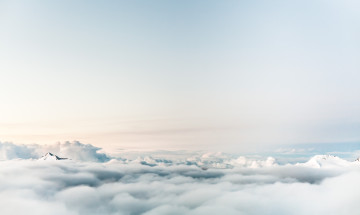“These models base their calculations on grid cells of approximately 50 km. We apply a smaller scale, assessing 50 km areas with 50-meter grid cells."
Best practice Cloud formation: the great unknown in current climate research
Global warming as a result of greenhouse gas emissions is having a wide variety of consequences. However, one of the most crucial processes - the formation of clouds - has not been the subject of much attention so far. The research group headed by Prof. Harm Jonker, Atmospheric Physics (Delft University of Technology) is seeking to change all that.
Researching cloud formation
Global warming is impacting a wide variety of processes; for example, the amount of water vapor being released into the earth's atmosphere is growing. “Cloud patterns are also being affected, but we're not exactly sure how”, Jonker explains. “However, we do know that clouds are a determining factor in terms of the amount of radiation that reaches the earth and the radiation leaving the earth's atmosphere. A warmer climate might result in more low-hanging clouds, which have the ability to reflect sunlight. This could potentially cushion the impact of the global warming process. However, the reverse scenario - less low-hanging clouds and thus a higher rate of warming - is also possible. We simply don't know how the process works yet.”
Climate model
Climate models can be designed to factor in specific cloud types, Jonker claims: “These models base their calculations on grid cells of approximately 50 km. We apply a smaller scale, assessing 50 km areas with 50-meter grid cells. We calculate along a timeline in three dimensions, so that takes a lot of computing power. But the end result allows us to accurately track the cloud formation process. For example, we're assessing how a one-degree rise in sea temperature would affect cloud formation. One of the key factors we're exploring is whether such a change would cause cloud surface reflections to increase or decrease.”
Visualisation
Visualisation is key to Jonker's research group: “Firstly, the images and animations are extremely useful when it comes to communicating the outcomes of our study. Secondly, the visualisation immediately tells us whether we've made any mistakes. If we've failed to set a specific boundary condition correctly or applied the wrong numerical schedule, it will show up on the visualisation. Visualisations are unforgiving in that sense. Thirdly, we also apply visualisation as a research tool. It's a real source of inspiration when we're formulating hypotheses.”
“We carry out our calculations on the national supercomputer, as they tend to involve a large quantity of data."
Remote visualisation
Jonker and his colleagues use SURFsara's Remote Visualisation Service. “It's been very effective so far”, Jonker enthuses. “We carry out our calculations on the national supercomputer, as they tend to involve a large quantity of data. Transferring that amount of data to our institute would take up too much time; creating the necessary visualisations also requires very powerful systems. Remote visualisation via SURFsara is far more efficient, as the data doesn't have to be transferred from the location where the visualisation is created. We only receive the images.”
Helpdesk that actually works
Jonker has been working with SURFsara for close to 20 years: “I still enjoy working with people who are always willing to help you solve problems. They're also extremely professional. Sometimes I joke that it's the only helpdesk in the Netherlands that actually works and doesn't have any waiting times.”
This article is from our annual report 2013
